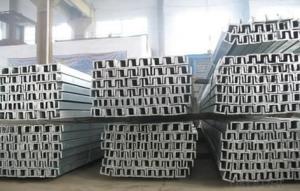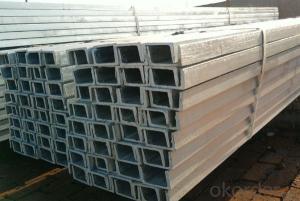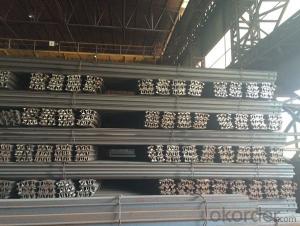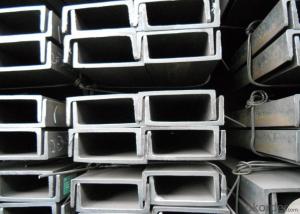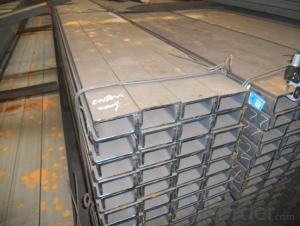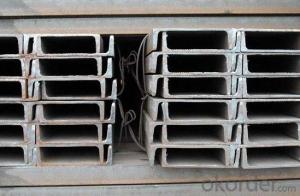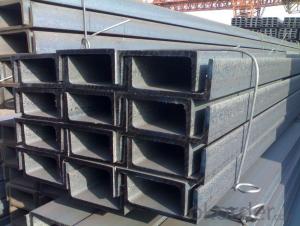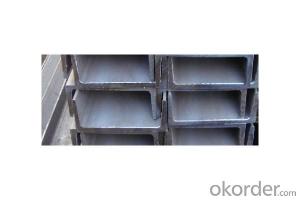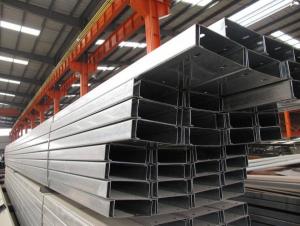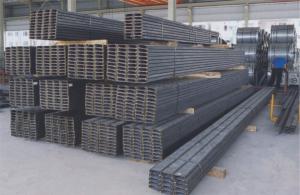Hot Rolled Steel Channel 150mm
- Loading Port:
- China Main Port
- Payment Terms:
- TT or LC
- Min Order Qty:
- -
- Supply Capability:
- -
OKorder Service Pledge
OKorder Financial Service
You Might Also Like
Product Description:
OKorder is offering Hot Rolled Steel Channel 150mm at great prices with worldwide shipping. Our supplier is a world-class manufacturer of steel, with our products utilized the world over. OKorder annually supplies products to European, North American and Asian markets. We provide quotations within 24 hours of receiving an inquiry and guarantee competitive prices.
Product Applications:
Hot Rolled Steel Channel 150mm are ideal for structural applications and are widely used in the construction of buildings and bridges, and the manufacturing, petrochemical, and transportation industries.
Product Advantages:
OKorder's Hot Rolled Steel Channel 150mm are durable, strong, and resist corrosion.
Main Product Features:
· Premium quality
· Prompt delivery & seaworthy packing (30 days after receiving deposit)
· Corrosion resistance
· Can be recycled and reused
· Mill test certification
· Professional Service
· Competitive pricing
Product Specifications:
Manufacture: Hot rolled
Grade: Q195 – 235
Certificates: ISO, SGS, BV, CIQ
Length: 6m – 12m, as per customer request
Packaging: Export packing, nude packing, bundled
Chinese Standard (H*W*T) | Weight (Kg/m) | 6m (pcs/ton) | Light I (H*W*T) | Weight (Kg/m) | 6m (pcs/ton) | Light II (H*W*T) | Weight (Kg/m) | 6M |
100*68*4.5 | 11.261 | 14.8 | 100*66*4.3 | 10.13 | 16.4 | 100*64*4 | 8.45 | 19.7 |
120*74*5.0 | 13.987 | 11.9 | 120*72*4.8 | 12.59 | 13.2 | 120*70*4.5 | 10.49 | 15.8 |
140*80*5.5 | 16.89 | 9.8 | 140*78*5.3 | 15.2 | 10.9 | 140*76*5 | 12.67 | 13.1 |
160*88*6 | 20.513 | 8.1 | 160*86*5.8 | 18.46 | 9 | 160*84*5.5 | 15.38 | 10.8 |
180*94*6.5 | 24.143 | 6.9 | 180*92*6.3 | 21.73 | 7.6 | 180*90*6 | 18.11 | 9.2 |
200*100*7 | 27.929 | 5.9 | 200*98*6.8 | 25.14 | 6.6 | 200*96*6.5 | 20.95 | 7.9 |
220*110*7.5 | 33.07 | 5 | 220*108*7.3 | 29.76 | 5.6 | 220*106*7 | 24.8 | 6.7 |
250*116*8 | 38.105 | 4.3 | 250*114*7.8 | 34.29 | 4.8 | 250*112*7.5 | 28.58 | 5.8 |
280*122*8.5 | 43.492 | 3.8 | 280*120*8.2 | 39.14 | 4.2 | 280*120*8 | 36.97 | 4.5 |
300*126*9 | 48.084 | 3.4 | 300*124*9.2 | 43.28 | 3.8 | 300*124*8.5 | 40.87 | 4 |
320*130*9.5 | 52.717 | 3.1 | 320*127*9.2 | 48.5 | 3.4 | |||
360*136*10 | 60.037 | 2.7 | 360*132*9.5 | 55.23 | 3 |
FAQ:
Q1: Why buy Materials & Equipment from OKorder.com?
A1: All products offered byOKorder.com are carefully selected from China's most reliable manufacturing enterprises. Through its ISO certifications, OKorder.com adheres to the highest standards and a commitment to supply chain safety and customer satisfaction.
Q2: How do we guarantee the quality of our products?
A2: We have established an advanced quality management system which conducts strict quality tests at every step, from raw materials to the final product. At the same time, we provide extensive follow-up service assurances as required.
Q3: How soon can we receive the product after purchase?
A3: Within three days of placing an order, we will begin production. The specific shipping date is dependent upon international and government factors, but is typically 7 to 10 workdays.
Q4: What makes stainless steel stainless?
A4: Stainless steel must contain at least 10.5 % chromium. It is this element that reacts with the oxygen in the air to form a complex chrome-oxide surface layer that is invisible but strong enough to prevent further oxygen from "staining" (rusting) the surface. Higher levels of chromium and the addition of other alloying elements such as nickel and molybdenum enhance this surface layer and improve the corrosion resistance of the stainless material.
Q5: Can stainless steel rust?
A5: Stainless does not "rust" as you think of regular steel rusting with a red oxide on the surface that flakes off. If you see red rust it is probably due to some iron particles that have contaminated the surface of the stainless steel and it is these iron particles that are rusting. Look at the source of the rusting and see if you can remove it from the surface.
Images:
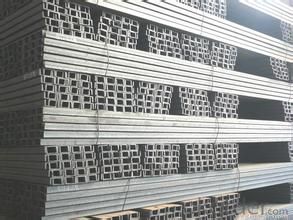
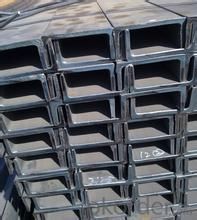
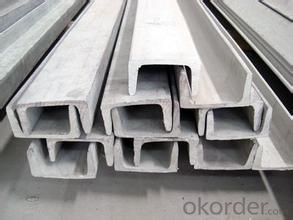
- Q: The pressure is: 50TLength: 1 meters or soMaterial: steel or steelSpecifications: please tell me how much you can use!Prawns help you ah! Urgent! Online, etc.!
- 50t concentrated force in the middle of the words.500KN x 0.25m=125KNmWx>=125000000/215=581395.3mm3More than [36a or more than 36a components are recommended.
- Q: Two floors of shops, exterior wall hanging marble, I would like to ask the general keel, channel, angle steel with what kind of specifications? Is the angle iron L30*3 channel 6.3 OK? Do keel labour contractor, how much is the market price? The older generation with the experience helped! Thank you
- This is calculated from the load analysis.
- Q: Can steel channels support electrical wiring?
- Indeed, electrical wiring can be supported by steel channels. In both construction and electrical contexts, steel channels are frequently employed to furnish both structural support and safeguarding for electrical wiring. Typically, they are mounted on walls, ceilings, or floors to mask and shield electrical cables. Steel channels possess great durability, enabling them to bear the weight of electrical wiring and guarantee its security and protection. Furthermore, the installation of steel channels is a straightforward process, offering an orderly and neat means of routing electrical wiring.
- Q: Can steel channels be used for scaffoldings?
- Yes, steel channels can be used for scaffoldings. Steel channels provide strength and durability, making them suitable for supporting the weight of workers and materials on scaffolds. They can be easily assembled and provide a stable platform for construction and maintenance work at various heights.
- Q: How do steel channels contribute to the sustainability of a building?
- Steel channels contribute to the sustainability of a building in several ways. Firstly, they are highly durable and have a long lifespan, reducing the need for frequent replacements or repairs. This minimizes the overall environmental impact associated with the production and disposal of building materials. Additionally, steel channels can be easily recycled at the end of their life cycle, reducing waste and conserving natural resources. Furthermore, steel channels are lightweight, allowing for more efficient transportation and installation, which reduces energy consumption during construction. Lastly, steel channels provide structural strength and support, allowing for the design of more sustainable and space-efficient buildings.
- Q: Are steel channels suitable for telecommunications infrastructure projects?
- Telecommunications infrastructure projects can benefit greatly from the use of steel channels. These channels possess numerous advantages that make them perfect for these types of projects. Firstly, they boast exceptional strength and durability, guaranteeing that the telecommunications infrastructure can endure harsh environmental conditions and bear the weight of the equipment. Additionally, steel channels are highly versatile and can be easily customized to meet the specific requirements of each project, including different sizes and shapes. Moreover, they exhibit excellent electrical conductivity, which is essential for efficient signal transmission in telecommunications systems. Furthermore, steel channels can be galvanized or coated to enhance their resistance to corrosion, thereby extending the lifespan of the infrastructure. Overall, steel channels provide a dependable and cost-effective solution for telecommunications infrastructure projects, making them an excellent choice for such applications.
- Q: How do steel channels contribute to the overall sound insulation of a structure?
- The overall sound insulation of a structure can be improved in several ways with the use of steel channels. Firstly, steel channels are commonly used as framing components in walls, ceilings, and floors, providing a rigid structure that reduces vibrations and lessens the transmission of sound waves. Moreover, steel channels can be filled with insulation materials like mineral wool or fiberglass, which further enhance their soundproofing capabilities. These materials absorb sound energy and decrease its transfer through the channels, effectively increasing the sound insulation of the structure. Additionally, steel channels allow for the creation of double-wall or staggered stud constructions, renowned for their excellent soundproofing properties. By incorporating multiple layers of steel channels and insulation materials, these constructions establish air gaps that act as sound barriers, preventing the passage of sound waves. This technique is particularly effective in reducing airborne noise, such as voices, music, or traffic sounds. Furthermore, steel channels facilitate the mounting of resilient sound isolation clips or brackets, which decouple walls or ceilings from the structure. This decoupling prevents vibrations and impact noise from transferring between different areas of the building, improving the overall sound insulation. To summarize, steel channels contribute to the overall sound insulation of a structure by providing a sturdy framework, allowing for the inclusion of insulation materials, creating double-wall or staggered stud constructions, and facilitating the use of resilient sound isolation clips. Through these techniques, steel channels minimize the transmission of sound waves, resulting in a quieter and more comfortable environment within the building.
- Q: How heavy is channel 1, 16? How do you calculate the formula?
- 17.2Kg16# channel mass per unit is 17.2Kg, this often used by people remember, the formula is 17.2 x 1=17.2Kg
- Q: What are the different shapes of steel channels available?
- Some of the different shapes of steel channels available include C channels, U channels, and MC channels.
- Q: What kind of low carbon steel or medium carbon steel are they?
- Low carbon steelLow carbon steel (low carbon steel) as the carbon content of less than 0.25% of the carbon steel, because of its low strength, low hardness and soft, it is also called the mild steel. It includes most of the ordinary carbon structural steel and some high-quality carbon structural steel, most of which are not used for engineering structural parts without heat treatment. Some of them are used for wear-resistant mechanical parts after carburizing and other heat treatment.The annealed structure of low carbon steel is ferrite and a small amount of pearlite, its strength and hardness are lower, and its plasticity and toughness are better. Therefore, its cold forming property is good, and cold forming can be carried out by curling, bending and stamping. This kind of steel also has good weldability. Carbon content from 0.10% to 0.30% low carbon steel is easy to accept all kinds of processing, such as forging, welding and cutting. It is used to make chains, rivets, bolts, shafts and so on.Low carbon steel is generally rolled into angle steel, channel steel, I-beam, steel pipe, steel belt or steel plate. It is used to make all kinds of building components, containers, boxes, furnaces and agricultural machinery and so on. High quality low carbon steel is rolled into thin board, making deep drawing products such as automobile cab, engine cover, etc., also rolled into bars, used for making mechanical parts of low strength requirement. Low carbon steel is not treated by heat before use. The carbon content is above 0.15%. It is treated by carburizing or cyaniding. It is used for shaft, shaft sleeve, chain wheel and other parts which require high surface temperature and good wear resistance.
Send your message to us
Hot Rolled Steel Channel 150mm
- Loading Port:
- China Main Port
- Payment Terms:
- TT or LC
- Min Order Qty:
- -
- Supply Capability:
- -
OKorder Service Pledge
OKorder Financial Service
Similar products
Hot products
Hot Searches
Related keywords
